The LMS-1 stream: A fossil remnant of the early formation of the Milky Way
Khyati Malhan (MPIA, Heidelberg.)
Tuesday 12/10/2021 @ 14:00, Sala IV piano Battiferro
As per the LCDM cosmological model, the halo of the Milky Way was built up by the merging of numerous progenitor galaxies, as these dwarf galaxies brought in their own stellar populations (in the form of stars and globular clusters). Over time, the dwarf galaxies were tidally stripped by the Galactic potential, eventually leading to the formation of “stellar streams”. Therefore, stellar streams provide direct evidence of the hierarchical formation of our Galaxy. Surprisingly, most of the known dwarf galaxy streams are dynamically-young systems that were only recently merged into our Galaxy (~8-10 Gyr ago). These dynamically-old streams are likely to be discovered in the inner <10-20 kpc regions of the Galaxy, and they hold the key to unravel the early formation history of the Galactic Halo. I will talk about the “LMS-1” stellar stream that we detect by searching for wide streams in the ESA/Gaia EDR3 dataset using my STREAMFINDER algorithm. Using spectroscopic measurements from LAMOST, SDSS and APOGEE, we infer that the stream is very metal poor ([Fe/H]~-2.1) with a significant metallicity dispersion (sigma[Fe/H]~0.4), and it possesses a large radial velocity dispersion (sigma_v =20\pm 4 km/s). These estimates together imply that LMS-1 is a dwarf galaxy stream. Both the orbit and metallicity of LMS-1 are remarkably similar to the globular clusters NGC 5053, NGC 5024 and another stellar stream “Indus”. Even Pal~5 cluster overlaps with LMS-1 in the dynamical energy-action (E,J) space. These findings make LMS-1 an important contributor to the stellar population of the inner Milky Way halo.

